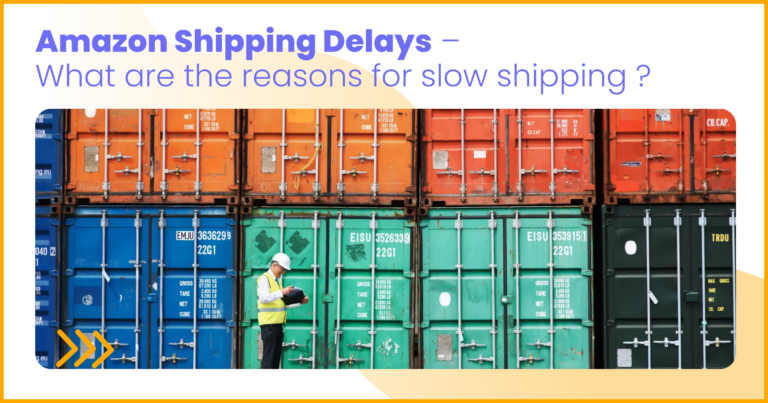Amazon Shipping Delays – What are the reasons for slow shipping and delays?

In the world of e-commerce, efficient shipping is paramount. Customers expect their orders to arrive swiftly and seamlessly, and any delays can lead to frustration and dissatisfaction. Amazon, being a juggernaut in the industry, is no exception to this rule. In recent times, Amazon shipping delays have become a prevalent concern for both sellers and buyers alike.
Understanding the reasons behind these delays is crucial for sellers aiming to maintain customer satisfaction and loyalty. Equally important is knowing what steps can be taken to mitigate these delays and ensure a smooth shipping process. Let’s delve into the underlying causes of Amazon shipping delays and explore actionable strategies for sellers to navigate through them effectively.
The Importance of Prompt Delivery on the Amazon Platform
- Building Customer Trust and Loyalty
Prompt delivery isn’t merely a checkbox to tick off; it’s the cornerstone of customer satisfaction on Amazon. Timely shipments build trust, encouraging repeat purchases and fostering brand loyalty. When customers receive their orders promptly, they are more likely to leave positive reviews and recommend the seller to others. - Impact on Buy Box Eligibility and Sales
Amazon’s algorithm favors sellers who consistently meet delivery expectations. By ensuring timely shipments, sellers enhance their chances of winning the Buy Box, which significantly influences sales volume. Conversely, delayed deliveries can lead to a drop in Buy Box eligibility, directly impacting sales and revenue.
Increase in Cases of Delayed Deliveries
- Surge in Online Shopping Demand
The COVID-19 pandemic accelerated the shift towards online shopping, resulting in a massive surge in demand for e-commerce goods. This unprecedented demand put immense pressure on logistics networks, leading to congestion in warehouses and delays in order processing. - Strain on Carrier Services
Shipping carriers faced unprecedented challenges in coping with the surge in parcel volumes. Limited transportation capacity, workforce shortages, and logistical constraints exacerbated by the pandemic contributed to delays in transit times. As a result, even expedited shipping services experienced delays beyond expectations. - Inventory Management Challenges
Effective inventory management is crucial for timely order fulfillment. However, fluctuations in demand, supply chain disruptions, and inventory inaccuracies pose significant challenges for sellers. Failure to maintain optimal inventory levels can lead to stockouts, backorders, and ultimately, delayed shipments.
Navigating through shipping delays on the Amazon platform requires a proactive approach and strategic planning. By understanding the underlying causes of delays and implementing effective mitigation strategies, sellers can minimize disruptions, maintain customer satisfaction, and drive sustainable business growth. Embracing agility, transparency, and innovation is key to thriving in the ever-evolving landscape of e-commerce.

Reasons for Slow Shipping on Amazon
When it comes to the reasons behind slow shipping on Amazon, several factors come into play, each contributing to the overall delay. Understanding these reasons is crucial for sellers to effectively address and mitigate shipping delays, ensuring customer satisfaction and business success.
Increase in orders: Increased demand during holidays or sales
One of the primary reasons for slow shipping on Amazon is the surge in orders during peak periods, such as holidays or major sales events like Prime Day or Black Friday. The spike in demand overwhelms the logistical infrastructure, causing delays in order processing and shipment. Increased orders strain warehouses, transportation networks, and fulfillment centers, leading to longer delivery times for customers.
During peak seasons, Amazon encourages sellers to anticipate and prepare for the surge in demand by optimizing inventory levels, staffing, and logistics operations. However, even with proactive planning, unexpected spikes in orders can still strain the system, resulting in shipping delays.
For sellers, it’s crucial to monitor market trends and anticipate peak periods to adjust their operations accordingly. Investing in additional resources, such as temporary staff or additional warehouse space, can help sellers manage the increased demand more effectively and minimize the impact of slow shipping on customer satisfaction.
By recognizing the influence of increased orders during peak periods, sellers can proactively prepare for these surges and implement strategies to mitigate shipping delays, ensuring a positive shopping experience for their customers.
Delivery problems: Delays from suppliers or carriers
One common cause of slow shipping on Amazon is delays from suppliers or carriers. Suppliers may encounter issues such as production delays, inventory shortages, or quality control issues, affecting the timely fulfillment of orders. Similarly, carriers may experience logistical challenges, capacity constraints, or unforeseen disruptions like weather-related delays or transportation bottlenecks.
Sellers should maintain open communication channels with their suppliers and carriers, proactively addressing any potential delays and seeking alternative solutions to expedite delivery. Additionally, diversifying supplier and carrier options can help reduce reliance on a single source and minimize the impact of disruptions on the shipping process.

Technical problems: Failures in the order processing or identification system
Technical glitches within Amazon’s order processing or identification system can also contribute to slow shipping times. These issues may arise from system failures, software bugs, or data inaccuracies, leading to delays in order confirmation, processing, and fulfillment.
Sellers should monitor their systems closely, promptly identifying and resolving any technical issues that could impede the smooth flow of orders. Implementing robust backup systems and contingency plans can help mitigate the impact of technical problems on shipping efficiency.
By addressing delivery challenges from suppliers and carriers and proactively managing technical issues within their systems, sellers can optimize their shipping processes and ensure a seamless experience for their customers on the Amazon platform.
By understanding and addressing the various reasons for slow shipping on Amazon, sellers can implement proactive measures to mitigate delays and ensure a seamless customer experience. From anticipating increased demand during peak seasons to maintaining strong relationships with suppliers and carriers, sellers play a critical role in optimizing shipping processes and meeting customer expectations for prompt delivery.
Amazon Sellers Slow Shipping Analysis
In the fast-paced world of e-commerce, slow shipping can have detrimental effects on Amazon sellers, impacting various aspects of their business operations and reputation. Understanding the consequences of slow shipping is essential for sellers to take proactive measures to address these issues and maintain a competitive edge on the platform.
Loss of customers: Negative shopping experience and the possibility of order cancellations
One of the most immediate and significant consequences of slow shipping is the potential loss of customers. When orders take longer than expected to arrive, customers experience frustration and dissatisfaction, leading to a negative shopping experience. This dissatisfaction can result in customers seeking alternative sellers for their future purchases or even opting to cancel their orders altogether.
In today’s competitive e-commerce landscape, where customer loyalty is paramount, sellers cannot afford to overlook the importance of timely shipping. Every delayed shipment represents a missed opportunity to delight customers and build long-term relationships. To address this issue, sellers must prioritize prompt order fulfillment and shipping, leveraging efficient logistics solutions and optimizing their supply chain operations.
By investing in streamlined shipping processes and ensuring timely delivery, sellers can minimize the risk of losing customers due to slow shipping and cultivate a loyal customer base that drives sustained business growth.
Damage to reputation: Reviews and seller ratings may be affected
Reputation is paramount in the competitive landscape of Amazon. Slow shipping can significantly impact sellers’ reputations, as dissatisfied customers may express their grievances through negative reviews and low seller ratings. Negative feedback not only undermines trust in the seller but also deters prospective customers from making purchases. As reviews and ratings play a crucial role in shaping buyers’ perceptions, sellers must strive to uphold high standards of shipping efficiency to safeguard their reputation and maintain a positive online presence.
Possible penalties: Failure to meet delivery obligations may result in penalties from Amazon
Amazon holds sellers accountable for meeting delivery obligations outlined in its service level agreements. Failure to uphold these obligations may result in penalties imposed by Amazon, including account suspensions, loss of Buy Box eligibility, or even expulsion from the platform. Sellers must adhere to Amazon’s performance metrics, such as on-time delivery rates and order defect rates, to avoid incurring penalties. By prioritizing efficient shipping practices and proactively addressing any issues that may arise, sellers can mitigate the risk of penalties and maintain compliance with Amazon’s policies.
The analysis of slow shipping on Amazon underscores the importance of timely order fulfillment for sellers. Beyond the immediate impact on customer satisfaction and reputation, slow shipping can have far-reaching consequences, including loss of customers, damage to reputation, and potential penalties from Amazon. By prioritizing shipping efficiency, maintaining transparent communication with customers, and adhering to Amazon’s performance standards, sellers can mitigate the risks associated with slow shipping and sustain a successful presence on the platform.
What Sellers Can Do About Delivery Delays
Addressing delivery delays requires proactive measures and strategic interventions from Amazon sellers. By implementing effective strategies, sellers can mitigate the impact of delays and uphold their commitment to timely delivery, fostering customer satisfaction and loyalty.
Customer support: Timely notification of delays and offer of alternative options
Effective customer support is crucial in mitigating the impact of delivery delays. Sellers should promptly notify customers of any delays, providing transparent communication regarding the reasons for the delay and realistic estimates for revised delivery times. Additionally, offering alternative options such as expedited shipping or partial refunds can help appease disgruntled customers and salvage their shopping experience. By demonstrating attentiveness and responsiveness to customer concerns, sellers can foster trust and loyalty even in the face of shipping challenges.
Process optimization: Improved quality for faster order processing and labeling
Optimizing internal processes is key to addressing delivery delays proactively. Sellers should assess their fulfillment workflows and identify areas for improvement to streamline order processing and labeling. Implementing efficient warehouse layouts, standardized packing procedures, and barcode scanning systems can expedite order fulfillment and reduce the likelihood of errors or bottlenecks. By prioritizing process optimization, sellers can enhance shipping efficiency and minimize the risk of delays affecting customer satisfaction.
Interaction with suppliers and carriers: Searching for solutions and suggesting possible improvements to the delivery process
Collaboration with suppliers and carriers is essential in resolving delivery delays and preventing future occurrences. Sellers should maintain open lines of communication with their partners, actively engaging in dialogue to identify root causes of delays and explore potential solutions collaboratively. This may involve negotiating revised delivery schedules, addressing logistical challenges, or implementing process improvements along the supply chain. By fostering a spirit of collaboration and continuous improvement, sellers can work towards optimizing the delivery process and ensuring timely order fulfillment.
Addressing delivery delays requires a multifaceted approach that encompasses proactive customer support, process optimization, and collaborative engagement with partners. By prioritizing transparency, efficiency, and cooperation, sellers can navigate shipping challenges effectively and uphold the standards of prompt delivery expected by Amazon customers.
Conclusion
Navigating delivery delays on Amazon presents a formidable challenge for sellers, but it also offers opportunities for growth and improvement. In this dynamic landscape, Profit Whales emerges as a strategic partner, offering innovative solutions to help sellers overcome shipping challenges and maintain competitiveness in the e-commerce arena.
By understanding the root causes of delivery delays, sellers can leverage Profit Whales’ expertise to implement proactive strategies tailored to their unique needs. From optimizing internal processes to fostering collaboration with suppliers and carriers, Profit Whales provides comprehensive support to enhance shipping efficiency and ensure a seamless shopping experience for customers.
Timely and transparent communication with customers is paramount, and Profit Whales equips sellers with the tools and resources to effectively manage expectations and mitigate dissatisfaction. Through personalized customer support and strategic guidance, Profit Whales empowers sellers to navigate delays with confidence, offering alternative options such as expedited shipping or partial refunds to maintain customer satisfaction.
Furthermore, Profit Whales encourages a culture of continuous improvement and innovation in fulfillment practices. By embracing cutting-edge technology, streamlining workflows, and investing in robust supply chain management solutions, sellers can stay ahead of the curve and minimize the risk of future delays.
While delivery delays pose significant challenges for Amazon sellers, Profit Whales stands ready to guide them toward success. By partnering with Profit Whales and adopting a proactive, customer-centric approach to addressing delays, sellers can strengthen their reputation, foster customer loyalty, and thrive in the ever-evolving world of e-commerce.
FAQ
What can you do if Amazon delays your package?
If Amazon delays your package, the first step is to check the estimated delivery date provided in your order details. Sometimes delays can occur due to unforeseen circumstances like weather conditions or high order volumes. If the delivery date has passed and there’s no update on your package, contacting Amazon customer service would be the next course of action. They can provide you with information on the status of your package and offer potential solutions, such as issuing a refund or reshipping the item.
Why would an Amazon package be delayed in transit?
An Amazon package might experience delays in transit due to various reasons such as unexpected weather conditions, logistical issues within the carrier’s network, or high volume of packages during peak seasons like holidays. Additionally, customs clearance for international shipments can also contribute to delays in delivery.
Can Amazon order be delayed?
Yes, Amazon orders can be delayed due to various reasons such as high demand, inventory issues, or logistical challenges. Delays might occur occasionally, but Amazon usually strives to meet their delivery estimates as closely as possible to ensure customer satisfaction. If your order is delayed, you can often track its status through your Amazon account or contact customer service for assistance.
Why hasn’t Amazon shipped my package?
There could be several reasons why your Amazon package hasn’t shipped yet. It might be due to high order volume, delays in processing, or issues with inventory availability. Checking your order status would be the best way to get specific information about your package.





